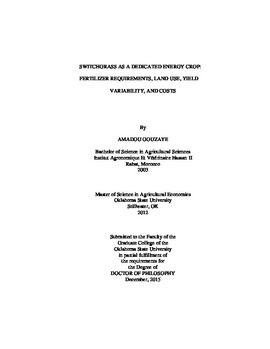| dc.contributor.advisor | Epplin, Francis | |
| dc.contributor.author | Gouzaye, Amadou | |
| dc.date.accessioned | 2016-09-29T18:45:23Z | |
| dc.date.available | 2016-09-29T18:45:23Z | |
| dc.date.issued | 2015-12 | |
| dc.identifier.uri | https://hdl.handle.net/11244/45356 | |
| dc.description.abstract | The U.S Energy Independence and Security Act of 2007 (EISA) mandates that 36 billion gallon of renewable fuels be marketed annually (if produced) by 2022 including 16 billion gallons of cellulosic biofuels. Switchgrass (Panicum virgatum L.) has been identified as a model native U.S. species to produce biomass that could be used as biorefinery feedstock. The U.S. Department of Energy's 2011 Billion-Ton Update reported that 16 to 24 million hectares of U.S. cropland and pasture could be converted to produce dedicated energy crops such as switchgrass. One advantage of switchgrass is that it can grow in a variety of environmental conditions including on low quality land and under relatively dry conditions. The present study explores different aspects of feedstock production from switchgrass. The first paper investigates the consequences of an extended switchgrass harvest window on production cost. The second paper estimates the value of seed from a genetically improved switchgrass variety. Papers 3 and 4 explore the expected consequences of restricting switchgrass production to less productive land on feedstock production costs as well as on biorefinery profitability for a case study region of 30 Oklahoma counties. | |
| dc.description.abstract | Delaying harvest beyond December resulted in an average 5.4% decline in harvested biomass per month. Delaying harvest beyond November did not result in a significant change in the N concentration in the harvested biomass. Delaying harvest did result in a significant decrease in both P and K content in the harvested biomass. Biomass production cost was similar across the five months considered. In paper 2, assuming a year for establishment, nine postestablishment production years, a farm-gate biomass price of $50 Mg-1, a discount rate of 6.5%, and environmental conditions similar to those that prevailed during the field experiment, the net present value of seeding a field in the region to Cimarron rather than Alamo would be $501 ha-1. Paper 3 and 4 found that restricting land use to les reproductive class IV land increases land requirement by 54% and feedstock cost by 29% compared to when land use is unrestricted. Restricting land use decreases the biorefinery expected annual net turns by 11 to 50%. | |
| dc.format | application/pdf | |
| dc.language | en_US | |
| dc.rights | Copyright is held by the author who has granted the Oklahoma State University Library the non-exclusive right to share this material in its institutional repository. Contact Digital Library Services at lib-dls@okstate.edu or 405-744-9161 for the permission policy on the use, reproduction or distribution of this material. | |
| dc.title | Switchgrass as a dedicated energy crop: Fertilizer requirements, land use, yield variability, and costs | |
| dc.contributor.committeeMember | Brorsen, B. Wade | |
| dc.contributor.committeeMember | Vitale, Jeffrey | |
| dc.contributor.committeeMember | Wu, Yanqi | |
| osu.filename | Gouzaye_okstate_0664D_14314.pdf | |
| osu.accesstype | Open Access | |
| dc.type.genre | Dissertation | |
| dc.type.material | Text | |
| thesis.degree.discipline | Agricultural Economics | |
| thesis.degree.grantor | Oklahoma State University | |
